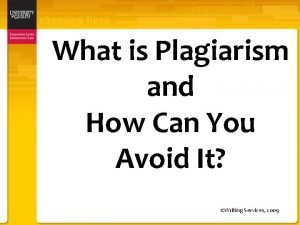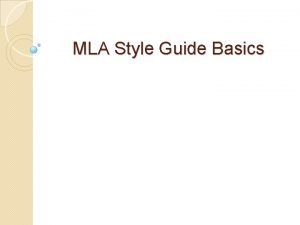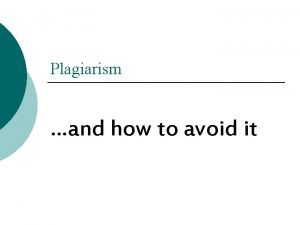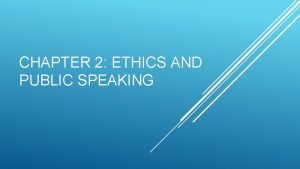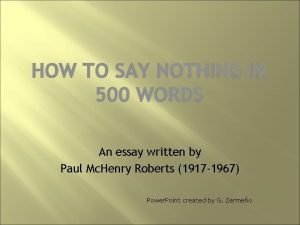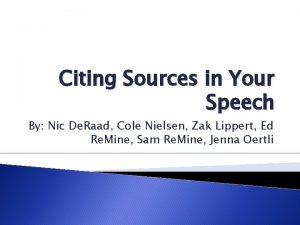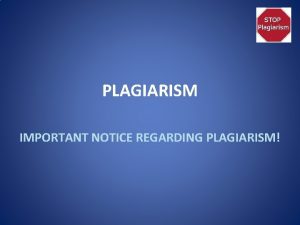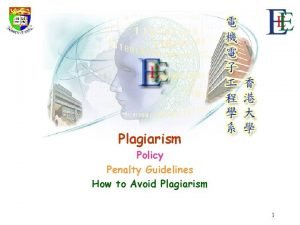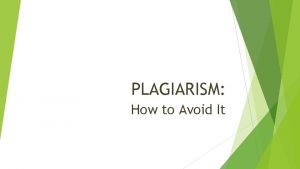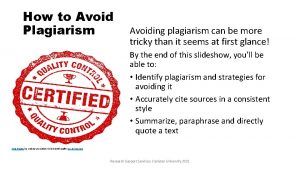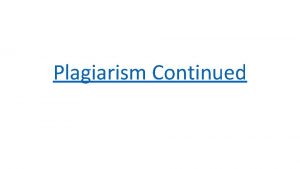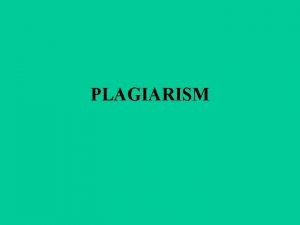PLAGIARISM HOW TO AVOID IT WHAT IS PLAGIARISM









- Slides: 9

PLAGIARISM HOW TO AVOID IT?

WHAT IS PLAGIARISM? Copying a researcher’s work and declaring it as your own. Not giving any references or credit to the original researcher. A serious offence in academic ethics.

TYPES OF PLAGIARISM Plagiarism Intended Unintended

DISADVANTAGES OF PLAGIARISM Giving references in a research work increases the credibility of your research. If references are not used, the readers will not know that what you are claiming in your research is backed by some evidence. Without references, a new research does not hold any attraction to the readers. Not mentioning the original researcher in your study is considered unethical and questions your own ethical standards.

HOW TO AVOID PLAGIARISM Always use quotation marks when including phrases from another research. Read the research, gather the main ideas, and then paraphrase them in your own words. Even when you have paraphrased, add citations within the text. Researches must be included in your work in a way that shows a critical analysis of the original research, rather than just copying the ideas. At the end of your work, include a “Works Cited” or “References” list, and add all the works that you have used to establish your research.

WHEN TO CITE AND DOCUMENT SOURCES It is not necessary to cite or document every phrase and every paragraph in your research. Facts and general knowledge do not need to be cited. Any piece of information that is unique and specifically learnt from another researcher’s work must be cited and documented.

HOW TO USE COPYRIGHTED WORKS A copyrighted work is registered in the name of its creator (author, songwriter, novelist, etc. ) Copyright publication houses and companies have these works registered to keep them safe from stealth and piracy. A copyrighted work cannot be accessed or used without paying some compensation and the permission of its creator/owner.

HOW TO CREDIT COLLABORATIVE RESEARCHES Many researches are a result of joint authorship by more than one authors. In such cases, issues of distribution of credits may arise. To avoid such issues, it is recommended that the roles of each author be clearly defined and stated in the research. By doing so, it is easier for other researchers to cite and credit collaborative works without the violation of academic ethics.

CONCLUSION Plagiarism is a violation of academic ethics and it affects the credibility of your research. It is very important and useful to cite and give references to the works of other researchers that you are using in your own research. Paraphrasing the extracted ideas and then citing them is the most accurate way to avoid plagiarism. Copyrighted works can only be accessed and used if the owners give permission. All ideas and information that have been taken from other researches have to be documented and cited in your research. General knowledge and universal facts do not need to be cited.
 Intentional plagiarism
Intentional plagiarism How will you avoid plagiarism
How will you avoid plagiarism Needed to avoid plagiarism
Needed to avoid plagiarism What is plagiarism and how to avoid it
What is plagiarism and how to avoid it Global, patchwork, and incremental are forms of
Global, patchwork, and incremental are forms of Slip out of abstraction
Slip out of abstraction To avoid mechanical delivery of speech sources
To avoid mechanical delivery of speech sources Basic rules of photography
Basic rules of photography Which type of plan shows the layout of the hvac system?
Which type of plan shows the layout of the hvac system? Dysmotility foods to avoid
Dysmotility foods to avoid

